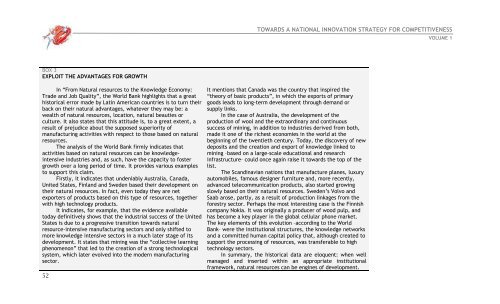Libro Blanco Vol I en Ingles
Libro Blanco Vol I en Ingles
Libro Blanco Vol I en Ingles
Create successful ePaper yourself
Turn your PDF publications into a flip-book with our unique Google optimized e-Paper software.
TOWARDS A NATIONAL INNOVATION STRATEGY FOR COMPETITIVENESSVOLUME 1BOX 3EXPLOIT THE ADVANTAGES FOR GROWTHIn “From Natural resources to the Knowledge Economy:Trade and Job Quality”, the World Bank highlights that a greathistorical error made by Latin American countries is to turn theirback on their natural advantages, whatever they may be: awealth of natural resources, location, natural beauties orculture. It also states that this attitude is, to a great ext<strong>en</strong>t, aresult of prejudice about the supposed superiority ofmanufacturing activities with respect to those based on naturalresources.The analysis of the World Bank firmly indicates thatactivities based on natural resources can be knowledgeint<strong>en</strong>siveindustries and, as such, have the capacity to fostergrowth over a long period of time. It provides various examplesto support this claim.Firstly, it indicates that und<strong>en</strong>iably Australia, Canada,United States, Finland and Swed<strong>en</strong> based their developm<strong>en</strong>t ontheir natural resources. In fact, ev<strong>en</strong> today they are netexporters of products based on this type of resources, togetherwith high technology products.It indicates, for example, that the evid<strong>en</strong>ce availabletoday definitively shows that the industrial success of the UnitedStates is due to a progressive transition towards naturalresource-int<strong>en</strong>sive manufacturing sectors and only shifted tomore knowledge int<strong>en</strong>sive sectors in a much later stage of itsdevelopm<strong>en</strong>t. It states that mining was the “collective learningph<strong>en</strong>om<strong>en</strong>on” that led to the creation of a strong technologicalsystem, which later evolved into the modern manufacturingsector.52It m<strong>en</strong>tions that Canada was the country that inspired the“theory of basic products”, in which the exports of primarygoods leads to long-term developm<strong>en</strong>t through demand orsupply links.In the case of Australia, the developm<strong>en</strong>t of theproduction of wool and the extraordinary and continuoussuccess of mining, in addition to industries derived from both,made it one of the richest economies in the world at thebeginning of the tw<strong>en</strong>tieth c<strong>en</strong>tury. Today, the discovery of newdeposits and the creation and export of knowledge linked tomining –based on a large-scale educational and researchinfrastructure– could once again raise it towards the top of thelist.The Scandinavian nations that manufacture planes, luxuryautomobiles, famous designer furniture and, more rec<strong>en</strong>tly,advanced telecommunication products, also started growingslowly based on their natural resources. Swed<strong>en</strong>’s <strong>Vol</strong>vo andSaab arose, partly, as a result of production linkages from theforestry sector. Perhaps the most interesting case is the Finnishcompany Nokia. It was originally a producer of wood pulp, andhas become a key player in the global cellular phone market.The key elem<strong>en</strong>ts of this evolution –according to the WorldBank– were the institutional structures, the knowledge networksand a committed human capital policy that, although created tosupport the processing of resources, was transferable to hightechnology sectors.In summary, the historical data are eloqu<strong>en</strong>t: wh<strong>en</strong> wellmanaged and inserted within an appropriate institutionalframework, natural resources can be <strong>en</strong>gines of developm<strong>en</strong>t.












![[Tam] Uygula[ya] - Bilim, Teknoloji ve Ä°novasyon Politikaları TartıÅma ...](https://img.yumpu.com/36820041/1/184x260/tam-uygulaya-bilim-teknoloji-ve-anovasyon-politikalara-tartaama-.jpg?quality=85)



